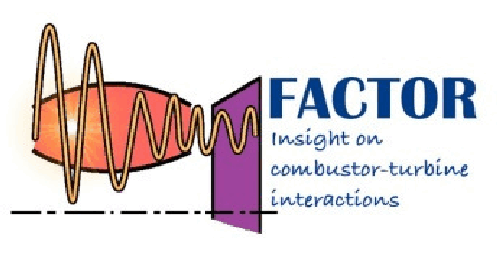FACTOR
 This project has received funding from the European Union’s Seventh Framework Programme for research, technological development and demonstration under grant agreement no 265985
This project has received funding from the European Union’s Seventh Framework Programme for research, technological development and demonstration under grant agreement no 265985
Full Aero-thermal Combustor-Turbine interactiOn Research
Project no. 265985
Call identifier. FP7-AAT-2010-RTD-1
Coordinator: Snecma (F)
start: 1st December 2010
duration: 48 months
status: partner
Contractors:
1 SNECMA SA (F)
2 AVIO S.P.A (I)
3 CENTRE EUROPEEN DE RECHERCHE ET DE FORMATION AVANCEE EN CALCUL SCIENTIFIQUE, CERFACS (F)
4 DEUTSCHES ZENTRUM FUER LUFT - UND RAUMFAHRT DLR (D)
5 GLOBAL DESIGN TECHNOLOGY SA (B)
6 ILA INTELLIGENT LASER APPLICATIONS GMBH (D)
7 INSTYTUT MASZYN PRZEPLYWOWYCH - POLSKIEJ AKADEMII NAUK IMP PAN (PL)
8 INDUSTRIA DE TURBO PROPULSORES SA ITP (E)
9 MTU AERO ENGINES GMBH MTU (D)
10 OFFICE NATIONAL D'ETUDES ET DE RECHERCHES AEROSPATIALES ONERA (F)
11 PROGESA S.R.L. (I)
12 ROLLS-ROYCE DEUTSCHLAND LTD & CO KG RRD (D)
13 ROLLS ROYCE PLC RRUK (UK)
14 SIEMENS INDUSTRIAL TURBOMACHINERY AB SIT (S)
15 TURBOMECA SA TM (F)
16 THE CHANCELLOR, MASTERS AND SCHOLARS OF THE UNIVERSITY OF CAMBRIDGE, UCAM (UK)
17 UNIVERSITA DEGLI STUDI DI FIRENZE, UNIFI (I)
18 THE CHANCELLOR, MASTERS AND SCHOLARS OF THE UNIVERSITY OF OXFORD, UOXF.DF (UK)
19 VOLVO AERO CORPORATION AB, VAC (S)
20 VON KARMAN INSTITUTE FOR FLUID DYNAMICS, VKI (B)
21 WYTWORNIA SPRZETU KOMUNIKACYJNEGO PZL - RZESZOW SA WSK (PL)
22 ARTTIC (F)
Links:
Abstract:
To achieve lower Specific Fuel Consumption (SFC) and CO2/NOx emissions, modern turbomachineries operate at high velocities and high temperature conditions. The lack of confidence in the prediction of combustor-turbine interactions leads to apply extra safety margins on components design. Therefore, the understanding of combustor-turbine flow field interactions is mandatory to preserve High Pressure Turbine (HPT) life and performance when optimising the design of new HPT.
The FACTOR objective is to optimise the combustor-turbine interactions design to develop low-cost turbines and reduce SFC by 2%, HPT weight by 1.5% and accordingly engine cost by 3% compared to the results from the TATEF2 and AITEB2 projects.
To achieve this objective, FACTOR will develop and exploit an innovative test infrastructure coupling a combustor simulator with a HPT for aerodynamic and aerothermal measurements.
The infrastructure will improve the knowledge of aerothermal external flows since the inlet profile of the turbine and the secondary flows will be modelled and optimised together in the same facility, under engine representative conditions. Collected data will be fed into the design techniques and simulation software used to optimise HPT components. In parallel, the use of advanced CFD (e.g. LES or DES) will provide new knowledge on wall temperature and heat transfer predictions. This will be particularly important to design future combustor-turbine systems in an integrated manner, especially for the next generation of lean burn combustion systems having complex and severe flow constraints.
By optimising the combustor-HPT interaction, FACTOR project will contribute to achieving the 50% CO2 and 80% NOx reductions ACARE 2020 environmental objectives. FACTOR will also strengthen the competitiveness of the European aeroengine industry by making available a new test infrastructure with experimental abilities beyond those of the US.
Publications:
